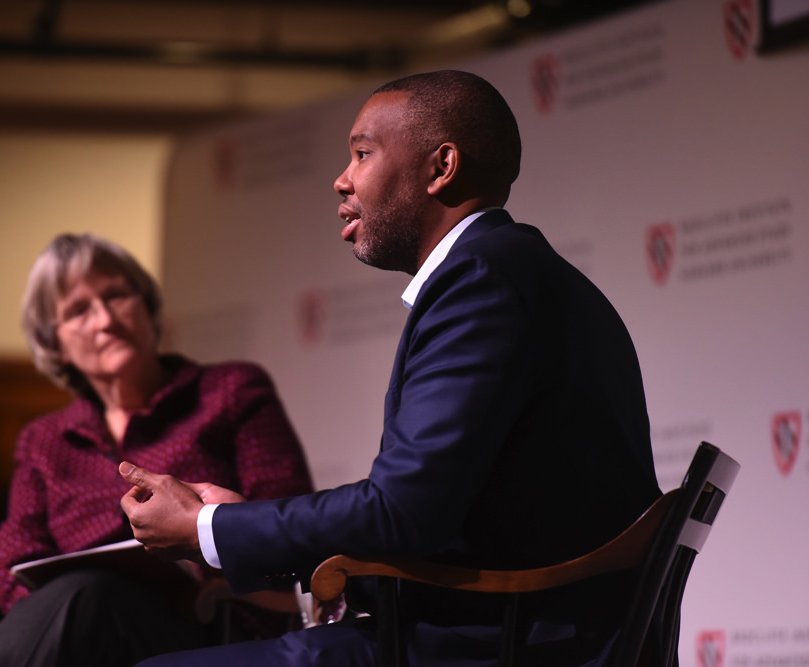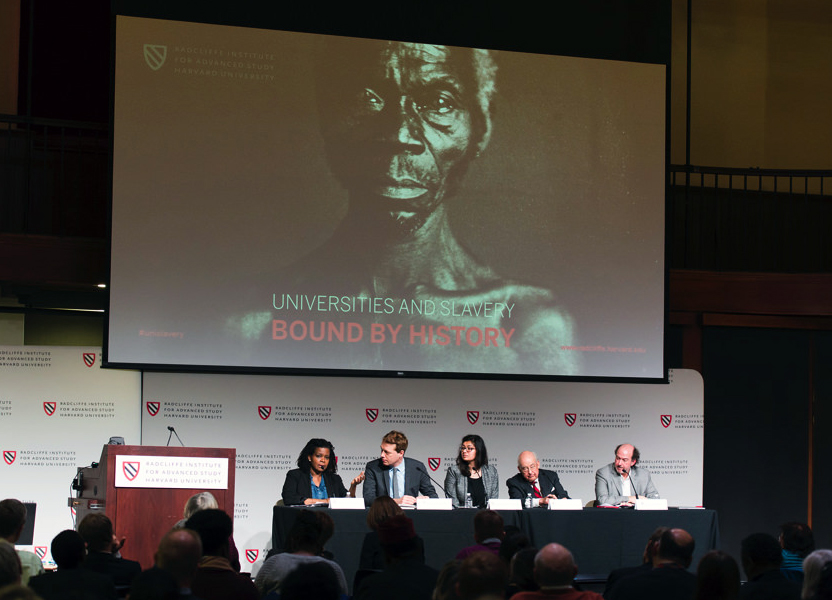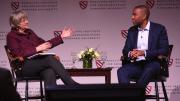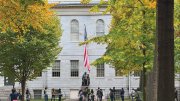Throughout last Friday’s daylong conference at the Radcliffe Institute on slavery and its historical ties to Harvard and other universities, the conversation kept coming back to something that writer Ta-Nehisi Coates had said during the morning’s keynote address. “We talk about enslavement as if it were a bump in the road. And I tell people: it’s the road. It’s the actual road.”
Coates was talking about slavery’s colossal formative influence on American history, from the founding to the present; but universities, too, have been finding out in recent years just how deep their own roots are sunk into, as Harvard historian Sven Beckert phrased it Friday, “the violence of the slave trader, the Middle Passage, the auction block, and the whip.” Researchers at Yale, Princeton, Brown, William & Mary, the University of Virginia, Rutgers, Georgetown—and Harvard—as well as other schools, have uncovered sometimes extensive historical connections to slavery: slave owners among the faculty and administration; significant gifts from slave-owning donors; endowment money and investments in the slave trade; campuses built and subsidized in part by slave labor. University scholars authored many of the racist scientific theories that legitimized slavery’s existence. One reminder of that scholarship on Friday was the shirtless man staring out from the conference program. Radcliffe dean Lizabeth Cohen explained that his name was Renty, a Congolese-born slave whose daguerreotype image was taken in 1850 on a South Carolina plantation and commissioned by Harvard professor Louis Agassiz. A biologist and geologist and a student of Earth’s history, Agassiz developed the theory of polygenesis, which denied the existence of a common human ancestor and held that blacks were inferior to whites. The Renty daguerreotype, along with others from Agassiz’s tour of Southern plantations, was lost for decades, until archivists at the Peabody Museum rediscovered it in 1976.
The North’s “Great Alibi”

Speaking with Faust about slavery’s legacy, Coates said, “My great fear is that if this is not dealt with, this will mark us for our whole history.”
Photograph by Tony Rinaldo
In his keynote, Coates was unequivocal about what he believes should happen next. “I think every single one of these universities needs to make reparations,” he said, as the auditorium broke into loud applause. “I don’t know how you get around that, I just don’t. I don’t know how you conduct research that shows that your very existence is rooted in a great crime, and just say ‘Well,’ shrug—and maybe at best say ‘I’m sorry,’ and you walk away. And I think you need to use the language of reparation, I think you need to say that word.” Coates’s Atlantic article “The Case for Reparations” launched a national conversation in 2014, arguing that the United States owes monetary damages to African Americans for centuries of slavery, segregation, and discrimination. In that article, and again in the Radcliffe auditorium, he spoke often of how blacks had been systematically “plundered.” The United States, he said, “was not a country with a little bit of slavery, but a vast slave society.” (Later, in conversation with him, President Drew Faust, a Civil War historian, agreed that recent scholarship had stripped away the North’s “great alibi” that it, unlike the South, was untainted by slavery.) Coates told conference-goers, “When you stand on the backs of other people who have been exploited, you have to—any institution that wants to teach people about morals and ethics, you have to do the right thing and make some amends. I just don’t know how you get around that.”
Later, discussing the chain that links slavery to contemporary ills like mass incarceration, Coates offered another caution: “My great fear is that if this is not dealt with, this will mark us for our whole history. It’s that deep, that profound, that threatening.”
Acknowledgement “Cannot Be Purely Symbolic or Rhetorical.”
Other speakers, including Faust, echoed that same sentiment, though with less specificity. “We cannot successfully move forward as a university, as a nation, or as citizens, without acknowledging this history and making it important to the understanding of our present,” said Harvard’s Beckert. “And to be meaningful, that acknowledgement will have to have economic and political consequences; it cannot be purely symbolic or rhetorical.” Stanford historian James T. Campbell, who a decade and a half ago led Brown’s effort to research its own past, said, “There has to be some response in the present to what you know about the history.” Conceding the impossibility of any full remedy, he added, “Nothing you do in the present even approaches the significance and scale and scope of the crime. That doesn’t mean you can’t do anything.” Adam Rothman, a Georgetown historian involved in that university’s archival effort, asked how many in the audience thought his university ought to help subsidize the education of people descended from slaves that it had owned in the early 1800s. Most hands went up.
As schools move forward in their efforts to reckon with centuries-old questions that have suddenly become urgent, Coates offered a few bits of advice. For one thing, he said, “Do not limit the study of enslavement to slavery.…Recognize that the plunder of enslavement does not end with enslavement.” He also counseled them to “listen, and don’t be self-congratulatory, and don’t get too mad.” People will be angry with them, he warned, and with good reason. “The worst thing you can do is retreat into your shell.…You’ve got to listen. You’ve got to listen, and you’ve got to hear that anger. It comes from a deep, deep place.”

Seated beneath an image of the daguerreotype of the slave Renty, panelists (left to right) Annette Gordon-Reed, Sven Beckert, Alexandra Rahman, Daniel R. Coquillette, and Julian Bonder spoke about the legacy of slavery at Harvard.
Photograph by Kevin Grady
Harvard’s Slave History
The Harvard conference was the latest major acknowledgement of its kind. (An accompanying exhibit, “Bound by History: Harvard, Slavery, and Archives,” is on display at Pusey Library.) Convened by the Radcliffe Institute, it was prompted by an op-ed in the Crimson last March, in which Faust called for a fuller examination of Harvard’s “mostly untold story.” The day’s discussions drew an overflow crowd of nearly 500 (plus another 1,000 watching online), including community members from outside academia and scholars from more than two dozen institutions. In her opening remarks, Faust declared that Harvard had been “directly complicit” in slavery from the college’s earliest days in the seventeenth century until the system of bondage ended in Massachusetts in 1783. After that, “through financial and other ties with the slave South, Harvard continued to be involved with slavery,” she said, “up until the time of emancipation.”
Much of that history was unearthed by Beckert, who in 2007 began leading an undergraduate research seminar on a subject that at the time was still a mystery. (This was before any official University blessing or encouragement for the research.) In 2011, he and his students detailed their findings in a booklet, “Harvard and Slavery: Seeking a Forgotten History.” On Friday, one of those students, Alexandra Rahman ’12, now a doctoral candidate at Harvard Business School, laid out one discovery from the seminar’s work: the collaboration between Harvard botanist Oakes Ames and West Indian sugar merchant Edwin Atkins. A slave owner in Cuba, Atkins made gifts to Harvard, and in 1899, the University established a botanical research station on Atkins’s sugar plantation; it was 13 years after Cuba’s emancipation of slaves, and Atkins hoped the research conducted there by Harvard students would help him transition from human to mechanized labor. Rahman quoted from a letter Ames wrote during one of his visits to the plantation, in which the professor makes rueful mention of the giant bell whose “doleful” note had once driven Atkins’s slaves to and from work. “But it’s interesting that he doesn’t go on to address that this is a problem,” Rahman said. The gist of Ames’s letter, she added, is “that this is an issue that people faced a long time ago, and isn’t antiquity fascinating. This was 20 years after slavery, and he was working for the slave owner.”
There were worse stories. Daniel Coquillette, Harvard Law School’s Warren visiting professor of American legal history, and the author of the 2015 book, On the Battlefield of Merit: Harvard Law School, the First Century, gave an account of Isaac Royall, whose bequest led to the 1817 founding of the law school and whose newly revealed slave legacy roiled the campus last year with intense protest and controversy. A West Indian planter and strikingly cruel man, Royall owned a sugar plantation on the island of Antigua during the eighteenth century. Sending gasps through the audience, Coquillette described how Royall brutally suppressed a major slave revolt there in 1736. More than 350 slaves had mobilized, but “at the last moment,” Coquillette said, they were betrayed. After it was over, 77 slaves were burned at the stake, and six others were drawn and quartered. The leader of the uprising, a slave named “King” Court, was gibbeted alive.
Following student-led protests, organized under the name Royall Must Fall, the law school decided last spring to change its shield, which was based on the Royall family crest. At the same time, professor Janet Halley, who is the school’s Royall professor—one of the country’s oldest named chairs—began taking first-year law students on tours of the slave quarters at Royall’s home in Medford, as a way of engaging the University’s heritage. On Friday, MIT historian Craig Steven Wilder noted that on campus after campus, students have consistently been the force pushing reluctant administrations toward uncomfortable reckonings with their racial histories. They “helped keep the conversation alive,” he said; they “kept us honest.” But he called it an unfair burden, especially for black students. The author of the 2013 book Ebony and Ivy: Race, Slavery, and the Troubled History of American Universities, Wilder said, “Perhaps it’s time for us to stop that. Perhaps it’s time for us to really take responsibility for our own history—our faculties, our trustees, our administrators—to confront the past, rather than depending on our students once again.”
“A Moment of Transcendent Courage”
As the day wound on, researchers from other universities shared experiences from their own excavations. Campbell, now at Stanford but previously at Brown, recalled how the research effort got under way there in 2003, when Ruth Simmons, then Brown’s president—and the first African-American president of an Ivy League university—announced that a steering committee would investigate and publish the school’s ties to slavery. “This was a moment of transcendent courage,” Campbell said. And although the announcement made news around the world, “there wasn’t a single peep from another university even suggesting that this was an act worthy of the university,” Campbell said. “Certain people just kind of waited to see.” Brown’s groundbreaking report, “Slavery and Justice,” published in 2006, inspired Beckert to launch his research seminar the following year.
There were moments during those years of study when the centuries collapsed into the present. Campbell remembered sitting up one night reading archived commencement addresses given by Brown students. One, delivered in 1798, was by James Tallmadge, who would later go on, as a New York congressman, to propose an amendment requesting that Missouri be admitted to the Union as a free state. The amendment never passed the Senate, but it precipitated the Missouri Crisis of 1819, an early step along the road to eventual civil war. In the commencement address, Tallmadge spoke about the “barbarous” slave traffic, before an audience that, Campbell guessed, was likely half-full of merchants connected to slavery. Tallmadge ended his speech by calling out the “absurd” idea that darker-skinned people were inferior to those with lighter skin. “He said this is a matter for future generations to investigate,” Campbell said. “I was reading this late at night—I was sitting by myself, and I just started to cry. Somebody left a message in a bottle.” The discovery proved to him that “We were not, as some alleged, projecting our values onto some past that you couldn’t get to. We were, in fact, engaging the past in precisely the terms that they had done. We were re-entering a conversation that had gone on on our campus for a really long time.”
“Telling the Story”
At Georgetown, Rothman, too, said he had been overwhelmed by the “emotional power vested in archival material.” That university’s recent investigation turned up evidence of the Jesuit-owned, slave-worked plantations and farms in Maryland that supported and sustained Georgetown’s educational and religious mission. Enslaved people also worked on the campus itself; at one point, Rothman reported, about 10 percent of all people on campus were slaves. The most devastating revelation, however, revolved around a sale in 1838 of Georgetown’s last 272 slaves, for the sum of $115,000, which was used to pay off the university’s debts (and keep its tuition free for students).
Tracing the fate of those sold slaves, Rothman and his colleagues discovered their descendants living all over the country—in Louisiana where the sale had taken many of the slaves, and in Minnesota, California, Maryland. Rothman encountered one of those descendants at an academic talk he gave last year, presenting archival material, including slaves’ baptismal records, letters the Jesuits had written about slavery, and records from the sale. He noticed a man standing at the back of the room who “didn’t fit”: he was African American, wearing a track suit, and covered in tattoos. “He raised his hand and said the names he was reading on the bill of sale were names he recognized from his ancestors.” Suddenly, Rothman said, the man began to break down, asking how priests who were supposed to protect their flock could have sold those people and “sent them to the wolves.” Said Rothman: “He was having a crisis of faith right there. And he said, ‘How could this happen, and what are we going to do about it?’ And I had no answer for him.”
Last fall the university announced it would grant legacy status to those descendants, giving them preferential admission to Georgetown, and also that it would change the names of two buildings on campus. Students “did not want to live with those names anymore,” Rothman said. “We tried to find new names for those buildings that would not erase this history but would bind us to this history in new ways.”
Moderator Evelyn Brooks Higginbotham, Thomas professor of history and of African American studies, asked Rothman if changing campus names lets universities off the hook too easily. It was a question that came up repeatedly throughout the conference. “It depends—you have to memorialize the renaming,” Rothman said, echoing comments from other panelists. “You have to be honest about these conflicts and moments; you have to historicize the name change. At Georgetown, it wasn’t good enough to take the names of the two Jesuits off the building. The real test of character comes when one renames the building and memorializes it.” (Coquillette offered similar remarks about Harvard’s decision to remove the Law School shield: “You don’t go around erasing this and that and pretend things didn’t happen.”)
Rothman noted that the facts about Georgetown’s past had never been hidden. Jesuit historians had been writing about it since the early twentieth century; a 1989 bicentennial history discussed it. Yet the story was not widely known. That disconnect, he said, shows the failure of scholarship to reach the broader public. “We have not been successful in telling the stories we know are true.” Later he added, “Part of the process of reconciliation is telling the story.”
“Walking into the Desert”
Higginbotham asked another important question during the panel: why now? One answer: it’s safer now. In 2004, the dismissal of a major reparations lawsuit against corporations eased the threat of litigation against universities like Harvard, which was speculated in the early 2000s to be a primary target. Plus, an emerging critical mass of institutions undertaking similar investigations offers safety in numbers. Wilder noted that for much of the past 20 or 30 years, “there was no upside” for universities to efforts like this. But now, he said, “the audience has changed.” What in the 1970s might have been a salient issue for small numbers of black students has now moved from the fringes to the mainstream. In part that’s because there are more students of color on campuses these days. But also, “There is not a lot of reason for us to assume that there are lots of students in the majority population who want to sit in front of stained glass windows of happy slaves picking cotton and embrace that as part of their educational experience,” he said. “The landscape has changed.”
Wading deeper and deeper into the day, as panelist after panelist talked about the profound effects and long roots of slavery, and the moral imperative to do something about it—even as that something remained not fully known—there was a gathering sense of the enormity of it all, that as these investigations have become easier to embark upon, they have also taken on a kind of inevitability. The problem is knowing how to proceed once the history is out there, how to find what is possible, how to get it right. Campbell said that the Brown steering committee members spent as much time agonizing over the report’s five pages of recommendations as they did discussing the historical research.
During the conference’s final panel, which drew together university leaders from South Africa and the Caribbean to discuss the legacy of slavery, racism, and apartheid on their campuses, Hilary Beckles, Vice Chancellor of the University of the West Indies, talked about the “pedagogy of forgetfulness” that had gripped West Indian governments for generations, and the danger of paralysis and indecision now. During the Nuremburg Trials, he said, judges and lawyers wrestled with the lack of precedent and jurisprudence to guide their work. The task before them was unavoidable, but the path was unknown. “They were becoming disillusioned,” Beckles reported. “One of tem actually said, in the midst of his despair, not knowing how to proceed, ‘We are walking into the desert, and somewhere out there is water. Let us go and find it.’ And with that metaphor, they moved through those trials.” Now universities must do the same, he argued. “All of us who are leaders of universities and institutions, we are walking into the desert. And somewhere in that desert is an oasis we need to find. And I think we should brace ourselves and prepare ourselves and walk into the desert.”









